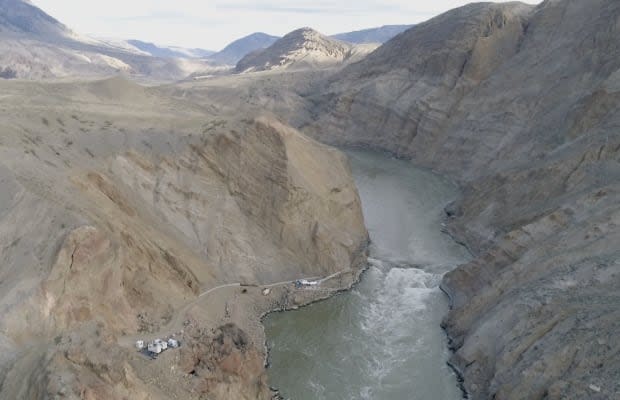Thousands of salmon fry released in B.C. river to restore populations devastated by Big Bar landslide

Thousands of salmon fry have been released in a river west of Prince George, B.C., in the hope they will help restore the salmon population devastated by the Big Bar landslide.
Monday's effort is part of an ongoing release of 101,000 chinook salmon fry that Fisheries and Oceans Canada says will avoid the early life stage mortality in the first year of a salmon's life.
"We've probably increased the survival by about 90 per cent over that first year, but they'll still have a really tough year ahead of them," Michael Crowe, the manager of biological programs for the Big Bar landslide response told CBC Daybreak Kamloops host Shelley Joyce.
He says, depending on the conditions, they expect approximately 25 per cent of the fry to make it to smolt — a juvenile salmon age reached before they migrate to the ocean.
"But that said, there's many more fish available to get to that smolt stage now because of the work we've done trying to enhance these fish."

The release was conducted using a transport tank supplied with oxygen to transport the fry to the access point of the Morkill River, a tributary of the Fraser River. Large tubes connecting the tank to the edge of the stream allowed the fish to be discharged into the water.
"Those fish will then have an opportunity to reside in that river for a full year before they actually head out to the ocean when they become two years old," Crowe explained.
The fry release was celebrated by Chief Leah Stump of the Nazko First Nation.
"I think it was a powerful experience for our members to witness. This did give a lot of hope to the community that the salmon would return."
She says the loss of hundreds of thousands of salmon in the past few years is devastating to her community.
"Our people used to use the entire summer to harvest salmon and to cure food for the winter, smoking it, canning it," she said. "In the past 15 years, we have seen little to no salmon return to Nazko."
In June of 2019, Fisheries and Oceans Canada officials discovered that an estimated 75,000 cubic metres of rock had slid into a Fraser River canyon just north of Lillooet, B.C., blocking a critical migration route for sockeye and chinook salmon.
The federal government is spending $176 million to install a permanent fishway through the site of the Big Bar landslide with an operational date set for the start of the early 2022 salmon runs.
Crowe said the release into the Morkill River is part of a much bigger plan to restore salmon populations in B.C. rivers.
"We are able to help in a number of smaller tributaries throughout the Upper Fraser, but we can't help them all," he said. "But these are the fish that we hope that ... when they come back as adults, we can use again to take some of those fish and enhance those and start rebuilding."

